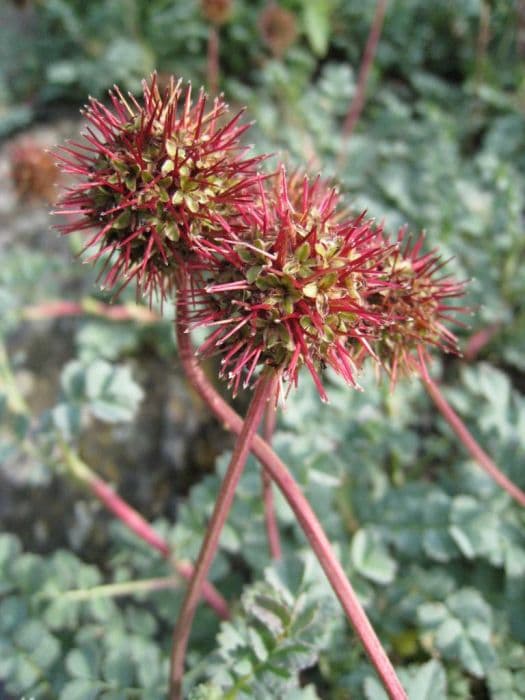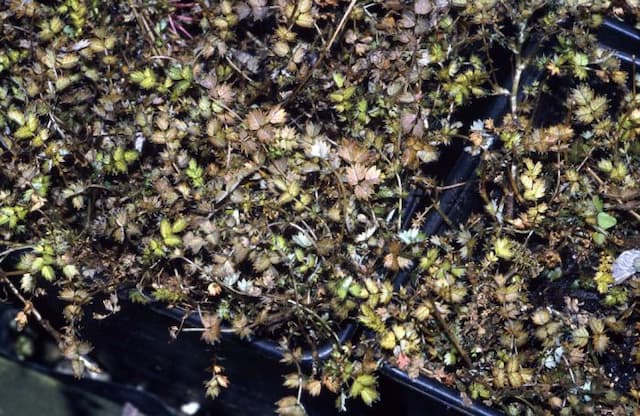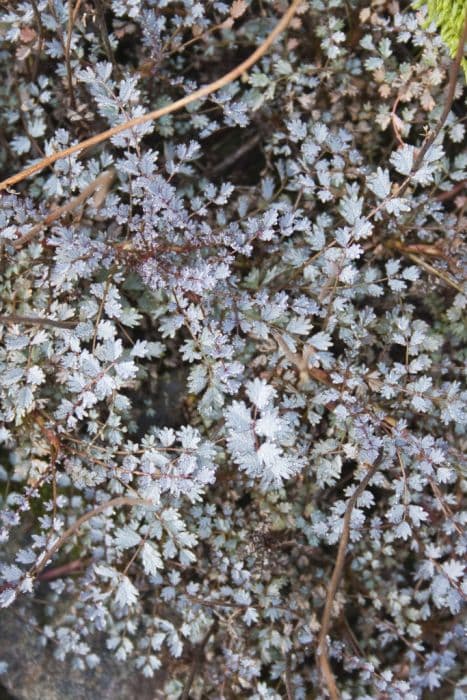Strawberry Fragaria × ananassa 'Evie 3' (PBR)

ABOUT
The Fragaria × ananassa 'Evie 3', commonly known as the strawberry plant 'Evie 3', is a perennial favored for its delicious fruit. The plant sports lush, green leaves with a slightly wrinkled texture and serrated edges. In contrast, the undersides are paler with a matt-like finish. These leaves are arranged in groups of three, known as trifoliates, and are borne on short, sturdy stems that sprawl out from the central crown of the plant. Amidst the leaves, delicate white flowers with golden centers emerge during the flowering season. These flowers are five-petaled and are usually small. They serve as a prelude to the highlight of 'Evie 3'—its strawberries. The berries begin as small green fruits and gradually enlarge, turning to a vibrant red color when ripe. These fruits are plump, typically conical in shape, and feature a textured surface dotted with tiny, embedded seeds. The overall impression of the Fragaria × ananassa 'Evie 3' is of a plant that is robust and green, accented with splashes of white and red from its flowers and fruits, thus providing not only a tasty harvest but also a visually appealing addition to gardens and allotments.
About this plant
 Names
NamesSynonyms
Garden Strawberry, Pineberry, Cultivated Strawberry, Strawberry 'Evie 3'
Common names
Fragaria × ananassa 'Evie 3' (PBR).
 Toxicity
ToxicityTo humans
Strawberry, the most common name of Fragaria × ananassa 'Evie 3' (PBR), is generally recognized as non-toxic to humans. Strawberries are widely consumed as food, and there are no known toxic effects from eating strawberries for most people. However, some individuals may have an allergic reaction to them, which could result in symptoms such as hives, itching, swelling, difficulty breathing, or anaphylaxis in severe cases.
To pets
Strawberry, also known for this variety as Fragaria × ananassa 'Evie 3' (PBR), is not toxic to pets. It is safe for most pets to consume strawberries in moderation. However, as with any food that is not a regular part of a pet's diet, strawberries can cause gastrointestinal upset in some animals if eaten in large quantities. This could potentially lead to symptoms such as diarrhea or vomiting. It is always best to introduce any new food to a pet's diet gradually and in small amounts.
 Characteristics
CharacteristicsLife cycle
Perennials
Foliage type
Deciduous
Color of leaves
Green
Flower color
White
Height
1 feet (0.3 meters)
Spread
1 feet (0.3 meters)
Plant type
Herb
Hardiness zones
5
Native area
Hybrid
Benefits
 General Benefits
General Benefits- Easy to Grow: This strawberry cultivar is known for being low-maintenance and suitable for both experienced and novice gardeners.
- High Yield: 'Evie 3' produces a plentiful crop of strawberries, which can provide a steady harvest throughout the growing season.
- Sweet Flavor: The berries are known for their deliciously sweet taste, making them excellent for fresh eating.
- Good for Containers: This variety can thrive in containers or hanging baskets, making it great for those with limited garden space.
- Attractive in Gardens: Offers beautiful white flowers in spring, making it visually appealing as an ornamental plant.
- Pollinator Friendly: The flowers attract bees and other pollinators, supporting local ecosystems.
 Medical Properties
Medical Properties- This plant is not used for medical purposes.
 Air-purifying Qualities
Air-purifying QualitiesThis plant is not specifically known for air purifying qualities.
 Other Uses
Other Uses- Natural Fabric Dye: The juice from strawberries can be used to make a pink to purple non-toxic fabric dye for coloring fabrics and yarns.
- Photography: The blossoms of the strawberry plant can be used as a subject in macro photography, showcasing intricate details of the flowers.
- Nail Polish: Strawberry juice can be mixed with clear nail polish to create a homemade pinkish tint.
- Art Supplies: Strawberries can be used to make natural watercolor paint for art projects, providing a range of pink shades.
- Edible Decorations: Strawberry plants can be grown in decorative arrangements for events, with the bonus of being able to eat the fruit afterwards.
- Plant Dye for Crafts: The leaves and berries can be used to dye paper giving it a unique natural tint for craft activities.
- Ink Making: Juice from the berries can be used as a base to create natural homemade ink for writing or calligraphy.
- Seed Mosaics: The tiny seeds of strawberries can be harvested and used to create mosaics and other textured art pieces.
- Garden Aesthetic: Strawberry plants can serve as ground cover in gardens to provide a lush, green carpet with the added benefit of seasonal fruit.
- Scented Candles: The aromatic essence of strawberries can be extracted and used in candle making to provide a sweet and pleasant fragrance.
Interesting Facts
 Feng Shui
Feng ShuiThe strawberry plant is not used in Feng Shui practice.
 Zodiac Sign Compitability
Zodiac Sign CompitabilityThe strawberry plant is not used in astrology practice.
 Plant Symbolism
Plant Symbolism- Love: As a member of the strawberry family, Fragaria × ananassa 'Evie 3' shares the strawberry's traditional association with love, due in part to their heart shape and red color.
- Fertility: Strawberries have been seen as a symbol of fertility because of their numerous seeds and lush growth.
- Perfection: With its symmetrical shape and sweet flavor, strawberries can represent the concept of perfection.
- Innocence: Strawberries are often associated with purity and innocence, possibly stemming from their bright, natural appearance and the fact that they are often enjoyed in their natural state without preparation.
- Passion: The rich red color of the strawberries evokes feelings of passion and intense emotion.
- Prosperity: Strawberries are sometimes symbolically connected to prosperity and abundance thanks to their prolific nature during the growing season.
 Water
WaterThe common name for Fragaria × ananassa 'Evie 3' (PBR) is the strawberry plant. Strawberries need regular watering to maintain moist, but not saturated, soil. It's important to water them evenly, aiming for at least 1 inch of water per week, which equates to about 0.623 gallons per square foot of garden space. During dry spells or in hot climates, they may require water up to three times a week. Water in the early morning to ensure that the foliage has time to dry out over the course of the day to prevent fungal diseases.
 Light
LightStrawberry plants, including Fragaria × ananassa 'Evie 3', thrive best in full sun conditions. They require at least six to ten hours of direct sunlight daily. The ideal spot for strawberry plants is an area that receives unhindered sunlight throughout the day, which promotes healthy growth and plentiful fruit production.
 Temperature
TemperatureFor strawberry plants, the ideal temperature range is between 65°F and 75°F. They can survive brief temperature dips down to 20°F, but prolonged exposure to cold or heat beyond these thresholds can be harmful. Extreme temperatures above 85°F may inhibit fruit production and cause the plants to go dormant.
 Pruning
PruningPruning is important for strawberry plants to remove dead leaves, spent flowers, and runners to promote better air circulation and fruit production. Pruning should occur after fruiting when plants have finished producing berries, which is typically in late summer. Old and dead leaves should be trimmed away, and excess runners snipped to prevent overcrowding.
 Cleaning
CleaningAs needed
 Soil
SoilThe best soil mix for a strawberry plant like the Evie 3 cultivar is well-draining and rich in organic matter with a pH between 5.5 and 6.8. A blend of loamy soil, peat moss, and compost with added perlite or sand for drainage can provide optimal growing conditions.
 Repotting
RepottingStrawberry plants like the Evie 3 should be repotted every one to two years, preferably at the beginning of the growing season. This ensures that they have fresh soil and adequate space to continue growing.
 Humidity & Misting
Humidity & MistingStrawberry plants, including the Evie 3, prefer moderate humidity levels, typically around 70-85%. They thrive in outdoor conditions where natural humidity aids their growth.
 Suitable locations
Suitable locationsIndoor
Place in bright, indirect light, and keep soil consistently moist.
Outdoor
Full sun, well-drained soil, space 18 inches apart.
Hardiness zone
4-9 USDA
 Life cycle
Life cycleStrawberry plant 'Evie 3' begins its life cycle as a seed, often after cold stratification which breaks dormancy. Germination follows, leading to the development of seedlings that establish a root system and produce several leaves. As it grows, the plant enters a vegetative stage, during which it develops runners or stolons that touch the ground and give rise to new daughter plants, thus expanding the plant's reach. It then transitions to the flowering stage, generally in the late spring, when it produces white flowers that are pollinated by insects or through self-pollination. Once pollinated, the flowers develop into red, juicy fruits, the strawberries, ready for harvest in early to mid-summer; fruits may be produced throughout the growing season in favorable climates. Finally, the plant enters dormancy in the winter, enduring the cold until the cycle restarts in spring.
 Propogation
PropogationPropogation time
Early Spring
The most popular method of propagation for the strawberry plant known as Fragaria × ananassa 'Evie 3' is through runner division. Strawberry plants produce long, trailing stems called runners that reach out from the main plant, and at certain points along the runners, small plantlets called "daughter plants" form. These daughter plants develop roots that can be pressed into the soil while still attached to the mother plant to establish their own root systems. Once the daughter plants have rooted and seem strong enough, which could take a few weeks, they can be severed from the mother plant and transplanted to their desired location. Ideally, this form of propagation should be done in the early spring or late summer to allow the young plants to establish before extreme temperatures set in. This method of asexual reproduction ensures that the new plants maintain the genetic identity of the parent plant.









